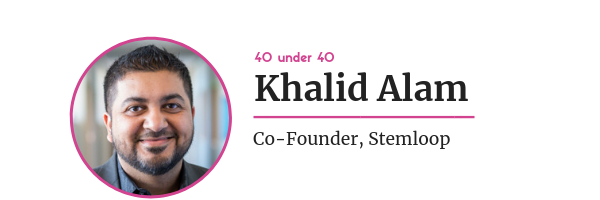In 2018, over 400,000 people died in the U.S. alone from lead exposure. With his startup Stemloop, which he spun out of Northwestern, Khalid Alam is harnessing the innate ability of microorganisms to sense and respond to their environment for the purpose of detecting lead and other contaminants in our drinking water.
Tell me about your research…
The most toxic places on earth are populated by niche microorganisms. They thrive in those settings because they have evolved sophisticated mechanisms to sense-and-respond to the environment.
The most toxic places on earth are populated by niche microorganisms. They thrive in those settings because they have evolved sophisticated mechanisms to sense-and-respond to the environment.
My research focuses on repurposing those natural mechanisms for new applications, such as the detection of lead in water. Our approach utilizes “cell-free” systems that contain only the machinery necessary for sensing and responding by producing a visible signal. The cell-free approach enables rapid development of sensors, storage and distribution without cold-chain, and eliminates concerns over the regulation and biocontainment of genetically modified organisms. At Stemloop, we’re focused on developing commercial applications of the technology.
Can you explain that to a non-scientist?
Chicago has issues with lead in drinking water. To test for lead, one would normally have to collect a sample from a single tap, ship it to a lab, pay hundreds of dollars, and wait weeks for answers. The traditional model makes it impossible to monitor drinking water at scale. Our technology allows us to produce low-cost, one drop water quality sensors that can easily be used on-site by non-experts. Simply add a drop of water and wait for a change in color indicating if you are above or below the safety threshold for the contaminant of interest.
The traditional model makes it impossible to monitor drinking water at scale. Our technology allows us to produce low-cost, one drop water quality sensors that can easily be used on-site by non-experts.
How could it someday impact patient lives?
It goes without saying that water is essential for life. With a booming population and a fast-changing climate, monitoring and maintaining safe water resources will be critical for public health. Our technology will decentralize and democratize the testing of water so that anyone, anywhere, can immediately find out if their water is safe to drink.
Our technology will decentralize and democratize the testing of water so that anyone, anywhere, can immediately find out if their water is safe to drink.


